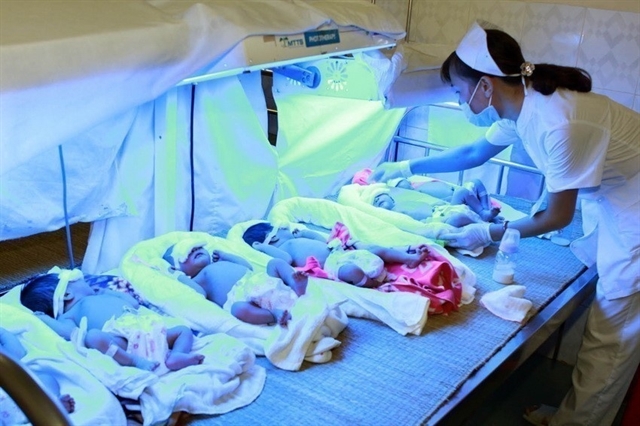 Society
Society

Việt Nam’s population quality has significantly improved during the past 10 years with improved education level and healthcare, especially maternal and child health, experts agreed at a conference held on Thursday in Hà Nội.

|
| A nurse takes care of new-borns at the Ngọc Lặc General Hospital in the central province of Thanh Hóa. — VNA/VNS Photo Dương Ngọc |
HÀ NỘI — Việt Nam’s population quality has significantly improved during the past 10 years with improved education level and healthcare, especially maternal and child health, experts agreed at a conference held on Thursday in Hà Nội.
The conference, organised by the General Office for Population and Family Planning (GOPFP), aimed to supply information to the press about the country’s population and development, and its strategy going forward.
Speaking at the conference, Nguyễn Văn Tân, former deputy director of the GOPFP, said the under-one mortality rate this year is 14 per 1,000 live births, down by two compared to 2009.
The maternal mortality rate in 2019 was 46 cases per 100,000 live births, down 23 cases compared to 2009.
These results suggested Việt Nam was on track to achieve its goal of reducing its maternal mortality rate ahead of the target in the National Action Plan to implement the 2030 agenda, which is 45 cases per 100,000 live births by 2030, he said.
Life expectancy has increased since 1989, rising from 65.2 years old then to 72.8 in 2009 and 73.6 years old in 2019.
Associate professor Nguyễn Thành Lợi, member of the Việt Nam Journalists Association’s executive board and editor-in-chief of Người làm báo (Journalists) magazine, said the country aimed to promote rational population distribution and take advantage of the golden demographics, understood as the proportion of labourers being double the dependent population, while adapting to population aging.
The work is part of targets in the Việt Nam Population Strategy, which was approved last month by Prime Minister Nguyễn Xuân Phúc.
Under the strategy, Việt Nam expects to have an average life expectancy of 75 years, with a minimum healthy life of 68 years, up from the current figure of 64.
Under the strategy, the average male height is expected to reach 1.68m and the female height is anticipated to reach 1.57m by 2030, an increase by four centimetres compared with present.
However, Tân said many things still needed to be done to achieve this.
Unequal sex ratio at birth remained high with 111.5 boys per 100 girls. If the problem continues, at least 2.3 million men in Việt Nam will not be able to find wives by 2050.
The rate of giving birth among those aged 10-17 is also an issue, with 3.3 per cent of all women giving birth being adolescents. The highest rate was in northern midlands and mountainous areas with 9.7 per cent.
The country currently has 8.3 per cent of its general school-age children out of school.
Đỗ Thị Hồng, deputy director of the Communications and Education Department under the GOPFP, said more education about gender equality was important.
More measures should be set up to take advantage of the golden demographics and adapt to the aging population.
In the long term, she said, women’s position should be enhanced in every field including politics, socio-economy and culture to improve gender equality.
She added that Việt Nam has been enjoying the golden demographics, so the country should invest in education, healthcare and other fields to improve people’s health, education and skills.
This would help drive the country’s development, she said.
According to the results of the 2019 National Population and Housing Census, Việt Nam’s population was more than 96.2 million as of April this year, raking third in Southeast Asia and 15th in the world. — VNS




